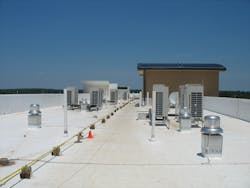VRV/VRF Give Contractors Options
What will the commercial HVAC landscape look like five years from now? Will there be a winner in the competition between traditional boiler/chiller/pipes/pumps central HVAC systems and VRF/VRV type, ducted and non-ducted systems? I’m looking for opinions here, so feel free to tell me that I’m full of it. (Note: VRV refers to Daikin’s invention, Variable Refrigerant Volume. VRF is Variable Refrigerant Flow, a product of other companies.)
Of course, I’m hoping that the ultimate winner will be the HVAC contractor.
You can read the discussion of VRF/VRV systems that appears in our June and July online editions.
Last month, Panasonic’s Jade Culbertson pointed out, “I believe commercial contractors are becoming more versed in the actual sequence of operation of the VRF systems. When VRF was first introduced to the North American market, it was such a drastic diversion from traditional hydronic and or air-to-air systems, it mystified most as to the operation of system.”
That’s for sure. VRF/VRV is a disruptive technology as Daikin’s Chris Bellshaw notes.
Contractors are catching on, according to the manufacturers.
“As the market grows to include more VRF systems, more HVAC contractors are gaining field experience with the technology,” says Brendan Casey, a New York City-based sales engineer for Fujitsu. “There seems to be a healthy trend toward diversification; installers are becoming involved with various forms and brands of HVAC equipment, much more so than just a few years ago. One way this has happened is through training.”
LG’s Kevin McNamara echoed those remarks, noting that his company has 22 training centers across the country. Contractors trained by LG are converting hesitant building owners to ductless systems, he said.
Said Mitsubishi’s Kevin Miskewicz, “In the last few years, and especially recently, we’ve absolutely seen a shift. We see it as a tipping point, wherein the building community and specifically commercial contractors have become increasingly educated about specifying VRF for a wide variety of applications.”
The manufacturers also emphasize the flexibility of their products and their ease of installation. A big misconception, the manufacturers said, was that VRF/VRV is a non-ducted product when, in reality, most installations are some combination of ducted and non-ducted air distribution. There are also products on the market that tie into VAV systems.
Controlling labor costs is always a big issue, and the VRF/VRV manufacturers promote labor savings.
Boasts Kevin Miskewicz, “ … jobs can be completed that much faster, helping to meet or beat tight deadlines. Long line lengths make it easier to locate units away from the zones they are conditioning and a two-pipe system means fewer refrigerant connections and piping than other three-pipe systems.”
The ascent of VRF/VRV systems drives vendors in the traditional market crazy. I know some of them are more than willing to challenge VRF/VRV manufacturers on their efficiency claims. Moreover, there has been progress on issues of both first cost and energy efficiency of traditional systems.
I recently attended an Armstrong Fluid Technology “Global Technology Summit” where the firm made a compelling argument for both the first cost and the energy savings of its Design Envelope pump packages. The packages come with the variable speed drive built in. And the company will fabricate any kind of chilled water package that a customer needs, reducing installation time and cost. On the piping side, plastics manufacturers, such as Uponor and Aquatherm, are pushing large diameter pipe into large commercial applications. Aquatherm will fabricate PP-R manifolds and headers in dimensions up to 24 inches, with the lighter-weight pipe increasing labor productivity.
There will always be a place for VAV and hydronic-based radiant cooling systems for larger buildings. The most threatened product category may be rooftop units. Contractors’ customers are concerned with first cost, operating cost and the comfort of their buildings. Whoever can deliver on those three considerations for a particular building in a particular location will win.
